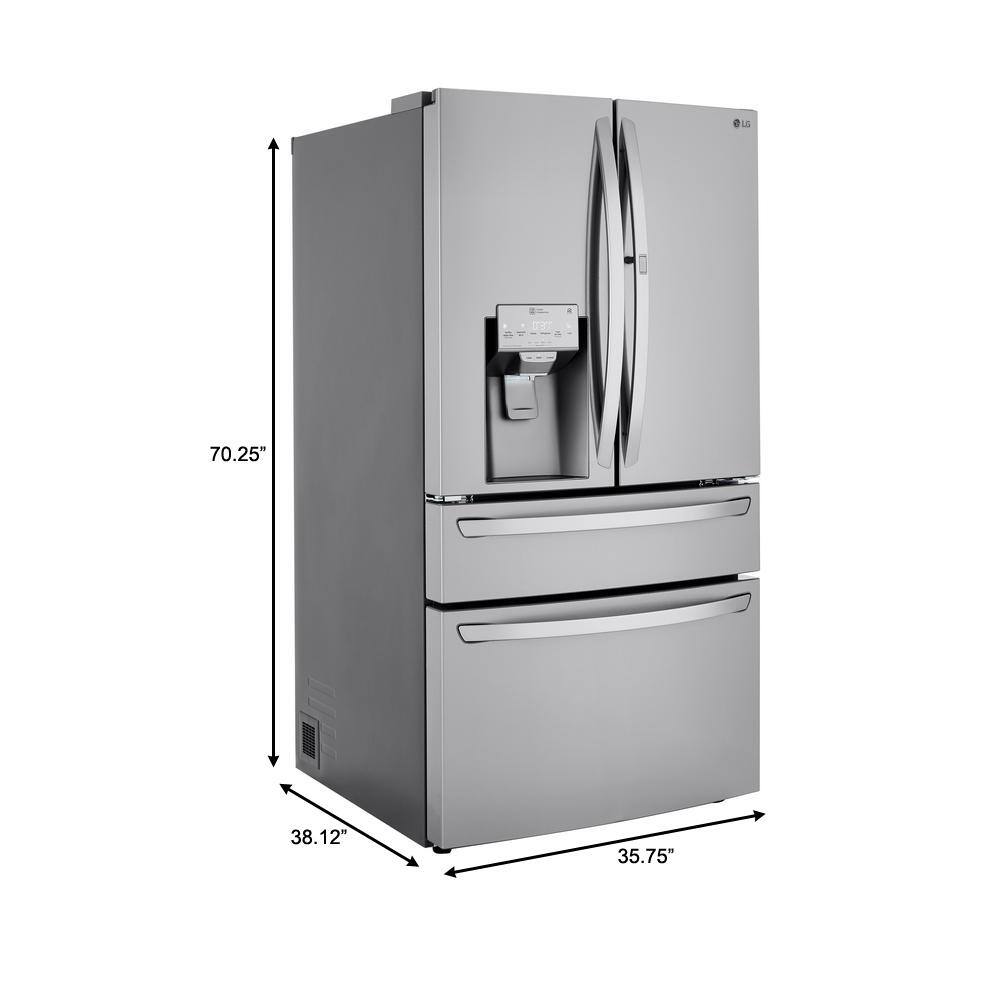KitchenAid 20 cu. ft. French Door Refrigerator in Stainless Steel, Counter Depth
EXTENDFRESH Temperature Management System helps keep food fresh. Interior water dispenser provides easy access to filtered water. Produce Preserver helps keep fruits and vegetables fresh.
This 20 cu. ft. refrigerator has a counter-depth design that gives it a built-in look. But the beauty of this French door refrigerator goes beyond the exterior. The ExtendFresh Temperature Management System and Produce Preserver help keep food fresh. LED lighting throughout the refrigerator makes food easy to find on every level.
- ENERGY STAR-qualified, meets government standards to help conserve natural resources and save money on utility bills
- Interior water dispenser is conveniently located for easy access to ice-cold filtered water
- An automatic ice maker ensures a constant supply of ice on hand at all times for entertaining and everyday use
- Filtration system reduces contaminants from tap water running through the ice maker and water dispenser to help keep ice cubes and drinking water clean and fresh-tasting
- Electronic controls are conveniently located in the front of the refrigerators interior to make them easy to reach
- ExtendFresh temperature management system uses sensors in the refrigerator and freezer to help ensure all your ingredients remain at the appropriate temperature so they stay fresh and tasty
- 5 cantilever shelves in the fresh food compartment are made of spill-proof glass, so even when accidents happen, the mess is kept to a minimum
- A freshchill temperature-controlled full width pantry lets you properly store foods ranging from meats to produce by allowing manual adjustment of the amount of cold air that enters the drawer
- Humidity-controlled crispers provide adjustable humidity control, giving you a dedicated storage option to keep fresh food at optimum humidity levels
- A produce preserver absorbs ethylene gas emitted by many fruits and vegetables, causing them to over ripen, by removing ethylene, the produce preserver helps extend freshness
- Metal wine rack provides a durable storage solution for up to four bottles of wine or 2 l containers and can be removed for additional storage flexibility
- A dairy bin and 2 Gal. storage shelves built into the door give you even more storage options for all of your groceries
- Metallic accents on the shelf trim provide a touch of elegance and complement the high gloss interior finish of the refrigerator
Additional information
| Depth (Excluding Handles) | 26.88 |
|---|---|
| Depth (Including Handles) | 29.38 |
| Depth (Less Door) | 24.13 |
| Depth With Door Open 90 Degrees (In) | 43.13 |
| Height to Top of Door Hinge (in.) | 70.13 |
| Height to Top of Refrigerator (in.) | 68.88 |
| Product Depth x Height x Width (in.) | 30.5 x 70.13 x 35.75 |
| Refrigerator Width (In.) | 36 |
| Certifications and Listings | UL Listed |
| Manufacturer Warranty | 10-year Limited Warranty: Year 1, Limited Parts & Labor Warranty; Years 2-5, Limited Parts & Labor Warranty on Cavity Liner and Sealed Refrigeration System; Years 6-10, Limited Parts Warranty on Sealed Refrigeration System |






by Pamela
I love this refrigerator. It fits perfectly in my kitchen.
by Chris
installed 30 days ago in new kitchen, along with 4 other kitchenaid appliances
by Medic
I bought this refrigerator for the name and quality and I love the layout in where everything is located and how I can change up shelves!
by Anthony
[This review was collected as part of a promotion.] Overall design of fridge is quite nice. French doors very light and easy to open but seals up well upon closing. Shelving is very modular inside although the corners can be chamfered down a lot for safety (corners are sharp!). Door shelving is also very modular which is a plus. The optional wine rack that hangs under one of the shelves is a nice option to have and its good that its not a permanent mount for those who don’t use it. Bottom freezer storage is wire racks. Not sure if I like the trapezoid type design instead of a more rectangular design to enable more storage space. I still prefer a full plastic bin over wire racks but I can accept the wire racks also which is more efficient with cooling air flow. Drawer shelving plastic is quite cheap compared with previous Kenmore fridge. The drawers rely on sliding mechanism and not smooth rolling, they do NOT close with the close so care must be taken to first close the drawers and then close the door. Finally unit comes with a standard water filter installed and can make ice and/or provide filtered water dispensed on the left side of the fridge inside. The fridge is also quite quiet when cooling but when ice is dropped into the bin inside the freezer it is quite loud. Overall pricing is not too bad considering the warranty included and it is a Kitchen Aid brand.
by Spice
The family likes the new fridge, no more fighting with the GE garbage water/ice dispenser.
by Fridge
I bought this a month ago. Looks great and is very functional. Only reason it didn’t get 5 stars from me is that I was surprised in how little effort it takes to open, makes me think it doesn’t seal very tight.